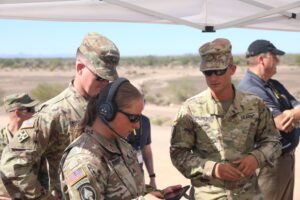The Army’s recent Project Convergence (PC) demonstration showed progress in getting after key data fabric and resilient satellite communications (SATCOM) for the future tactical network, a lead official said Tuesday, while highlighting a need to build in more interoperability as the modernization effort moves forward.
Brig. Gen. Jeth Rey, director of the Army’s Network Cross-Functional Team (CFT), detailed his specific lessons learned from PC ‘21 on Thursday and how industry can help further those technology areas of interest in upcoming network modernization capability drops.

“What I realized out at PC ‘21 is that there was no way we could have achieved what we did at PC ‘21 with sensor-to-shooter [capabilities] without having the data fabric. So that’s why I told the team we have to push to get a data fabric earlier rather than later,” Rey said during remarks at a technical exchange meeting with industry.
On the data fabric piece, which officials have cited as a critical component to sharing information rapidly on the future battlefield, Rey said PC ‘21 showed success in accelerating machine-to-machine data flow, improving sensor-to-shooter capability and facilitating joint formation exchanges.
The Army is currently working through two-year capability drops, or CAPSETs, to transform its tactical network, with CAPSET 21 currently being fielded, CAPSET 23 in the final development stages ahead of a critical design review in April 2022, and officials currently working to inform characterization for CAPSET 25’s network design goals.
Rey also pointed to resilient SATCOM and bandwidth virtualization to help with automating between primary, alternate, contingency and emergency, or PACE, communications, noting PC ‘21 highlighted improvement in those areas with opportunities for industry to push capabilities forward.
“What we did differently at PC ‘21 is that we brought…a bandwidth virtualization piece on it where we used [Low-Earth Orbit] and [Mid-Earth Orbit], we didn’t use [Geostationary Orbit] out there, but we were able to combine commercial and military SATCOM together, aggregate that bandwidth and then actually utilize it to move data on the battlefield. It was very, very impressive to see it done,” Rey said. “We’re working to improve that capability and the [C5ISR Center] is working hard to get that done. And I know we’re going to get there sooner rather than later.”
PC ‘21 placed a focus on participation from the other services to help further Joint All-Domain Command and Control initiatives, with Rey adding the Network CFT saw improvements in bringing different systems together to form a joint common operating picture (COP) while showcasing the need for baseline standards or characteristics to improve interoperability.
“Joint COP is a big deal for us across the board. With this capability, we were able to bring the Navy, the Marine Corps systems onto the [Command Post Computing Environment] and provide a joint COP onboard. This is a system that we’re going to need for the future but it’s definitely a challenge as we go forward,” Rey said.
Rey cited opportunities for industry to present concepts that could also help further the Army’s ability to provide communications relay capabilities for the aerial tier and push the boundaries of edge mesh network range extension.
“We did not realize how important it was to have an aerial tier overhead loitering for more than 20 to 26 hours and providing an extension of our network, but we realized it at PC ‘21. It’s important that we continue to move forward and find out if we can improve that capability, loitering for more than 48 hours or we would take a week if that can happen. That would be even better,” Rey said. “I’ll tell you what, they extended our mesh network more than we realized when we got to PC ‘21. It was a [Brigade Combat Team]-and-below environment but when they brought in the multi-sensors and autonomous systems out there it really stretched our network.”
The Army’s Future Vertical Lift CFT worked with the Network CFT at PC ‘21 to achieve a nearly three-times increase in its mesh network range extension with aerial assets, to include testing a new electric-powered, solar-charged fixed-wing drone from Kraus Hamdani Aerospace that allowed air and ground assets using different radios and waveforms to be seamlessly connected (Defense Daily, Nov. 9).